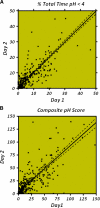Day-to-day discrepancy in Bravo pH monitoring is related to the degree of deterioration of the lower esophageal sphincter and severity of reflux disease
- PMID: 21359906
- PMCID: PMC3116124
- DOI: 10.1007/s00464-010-1529-5
Day-to-day discrepancy in Bravo pH monitoring is related to the degree of deterioration of the lower esophageal sphincter and severity of reflux disease
Abstract
Background: The Bravo capsule allows monitoring of esophageal acid exposure over a two-day period. Experience has shown that 24-32% of patients will have abnormal esophageal acid exposure detected on only one of the 2 days monitored. This variation has been explained by the effect of endoscopy and sedation. The aim of this study was to assess the day-to-day discrepancy following transnasal placement of the Bravo capsule without endoscopy or sedation and to determine factors related to this variability.
Methods: Bravo pH monitoring was performed by transnasal placement of the capsule in 310 patients. Patients were divided into groups based on the composite pH score: both days normal, both days abnormal and only one of the 2 days abnormal. Lower esophageal sphincter (LES) characteristics were compared between groups.
Results: Of the 310 patients evaluated, 60 (19%) showed a discrepancy between the 2 days. A total of 127 patients had a normal pH score on both days and 123 had an abnormal pH score on both days. Of the 60 patients with a discrepancy, 27 were abnormal the first day and 33 (55%) were abnormal the second day. Patients with abnormal esophageal acid exposure on both days had higher degrees of esophageal acid exposure and were more likely to have a defective LES compared to those with an abnormal score on only one day (35 vs. 83%, p=0.027).
Conclusion: Patients with a discrepancy between days of Bravo pH monitoring have lower esophageal acid exposure. Variability between the 2 days represents early deterioration of the gastroesophageal barrier and indicates less advanced reflux disease.
Figures




Similar articles
-
24-h multichannel intraluminal impedance-pH monitoring may be an inadequate test for detecting gastroesophageal reflux in patients with mixed typical and atypical symptoms.Surg Endosc. 2015 Jul;29(7):1700-8. doi: 10.1007/s00464-014-3867-1. Epub 2014 Nov 15. Surg Endosc. 2015. PMID: 25398192
-
Safety and tolerability of transoral Bravo capsule placement after transnasal manometry using a validated conversion factor.Am J Gastroenterol. 2007 Jan;102(1):24-32. doi: 10.1111/j.1572-0241.2006.00889.x. Epub 2006 Nov 13. Am J Gastroenterol. 2007. PMID: 17100980
-
Esophageal pH monitoring with the BRAVO capsule: experience in a single tertiary medical center.J Pediatr Gastroenterol Nutr. 2011 Oct;53(4):404-8. doi: 10.1097/MPG.0b013e3182203caa. J Pediatr Gastroenterol Nutr. 2011. PMID: 21519281
-
New esophageal function testing (impedance, Bravo pH monitoring, and high-resolution manometry): clinical relevance.Curr Gastroenterol Rep. 2008 Jun;10(3):222-30. doi: 10.1007/s11894-008-0047-2. Curr Gastroenterol Rep. 2008. PMID: 18625130 Review.
-
Use and utility of the Bravo pH capsule.J Clin Gastroenterol. 2008 May-Jun;42(5):571-8. doi: 10.1097/MCG.0b013e31815bb602. J Clin Gastroenterol. 2008. PMID: 18364590 Review.
Cited by
-
Clinical value of wireless pH-monitoring of gastro-esophageal reflux in children before and after proton pump inhibitors.BMC Gastroenterol. 2014 Dec 24;14:3. doi: 10.1186/s12876-014-0225-7. BMC Gastroenterol. 2014. PMID: 25539736 Free PMC article.
-
First agreement analysis and day-to-day comparison of pharyngeal pH monitoring with pH/impedance monitoring in patients with suspected laryngopharyngeal reflux.J Gastrointest Surg. 2012 Jun;16(6):1096-101. doi: 10.1007/s11605-012-1866-x. Epub 2012 Mar 27. J Gastrointest Surg. 2012. PMID: 22450948 Clinical Trial.
-
Early referral for 24-h esophageal pH monitoring may prevent unnecessary treatment with acid-reducing medications.Surg Endosc. 2013 Apr;27(4):1302-9. doi: 10.1007/s00464-012-2602-z. Epub 2012 Dec 12. Surg Endosc. 2013. PMID: 23232999 Free PMC article.
-
Esophagogastroduodenoscopy with conscious sedation does not interfere with catheter-based 24-h pH monitoring.World J Gastroenterol. 2013 Mar 21;19(11):1805-10. doi: 10.3748/wjg.v19.i11.1805. World J Gastroenterol. 2013. PMID: 23555169 Free PMC article.
-
Current Advancement on the Dynamic Mechanism of Gastroesophageal Reflux Disease.Int J Biol Sci. 2021 Oct 3;17(15):4154-4164. doi: 10.7150/ijbs.65066. eCollection 2021. Int J Biol Sci. 2021. PMID: 34803489 Free PMC article. Review.
References
-
- Tseng D, Rizvi AZ, Fennerty MB, Jobe BA, Diggs BS, Sheppard BC, Gross SC, Swanstrom LL, White NB, Aye RW, Hunter JG. Forty-eight-hour pH monitoring increases sensitivity in detecting abnormal esophageal acid exposure. J Gastrointest Surg. 2005;9(8):1043–1051. doi: 10.1016/j.gassur.2005.07.011. - DOI - PubMed
-
- Wiener GJ, Morgan TM, Copper JB, Wu WC, Castell DO, Sinclair JW, Richter JE. Ambulatory 24-hour esophageal pH monitoring. Reproducibility and variability of pH parameters. Dig Dis Sci. 1998;33(9):1127–1133. - PubMed
MeSH terms
Substances
LinkOut - more resources
Full Text Sources
Medical

